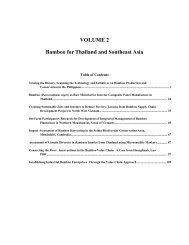WBC-VIII-Vol.4 – Resources – Forestry, Plantations and ... - BambuSC
WBC-VIII-Vol.4 – Resources – Forestry, Plantations and ... - BambuSC
WBC-VIII-Vol.4 – Resources – Forestry, Plantations and ... - BambuSC
You also want an ePaper? Increase the reach of your titles
YUMPU automatically turns print PDFs into web optimized ePapers that Google loves.
identification, apparent unsuitability of the species for the area, <strong>and</strong> the fact that this species was only planted in<br />
Kakamega, the species is not included in this analysis. Another case is that of Dendrocalamus. asper. The<br />
relatively good performance of this species under cultivation in Nairobi suggests that this species may be<br />
interesting for plantations. D. asper was planted in the Muguga trials but the species was not identified at the<br />
site, so no data was recorded for analysis. It is possible that D. asper was mixed up with D. br<strong>and</strong>isii. In<br />
Kakamega, a clump resembling D. asper was observed in the plot of D. br<strong>and</strong>isii. D. asper was however not<br />
originally included in the Kakamega trial site. Some elements of doubt therefore remain in the analyses <strong>and</strong><br />
taxonomical clarifications are required.<br />
Methodology<br />
The method of analyzing the sites involved the following steps:<br />
1) Observations were made on various clumps of each species <strong>and</strong> the number of culms <strong>and</strong> new shoots per clump<br />
was counted or estimated. In very dense clumps it was not possible to count the number of culms <strong>and</strong> therefore an<br />
estimate of the number of culms was made based on the number of culms counted for a particular area of the<br />
clump. Based on the counted <strong>and</strong>/or estimated number of culms of the sampled clumps of each species, average<br />
numbers of culms per clump per species was calculated.<br />
2) The observation of the clumps involved visually identifying small, medium, <strong>and</strong> large culms <strong>and</strong> measuring the<br />
circumference of selected samples using a measuring tape. Based on the measured samples of various sizes of<br />
culms of each species, <strong>and</strong> taking into account the fact bamboo culms are tapered from the base towards the tip of<br />
the culm, an average culm diameter was calculated for each species.<br />
3) The average height of the culms of each species was determined in many cases, roughly by observation, as well as<br />
accurately, by felling culms <strong>and</strong> measuring their precise length in meters. This method was applied by sampling<br />
culms in several clumps <strong>and</strong> an average height per species was calculated.<br />
4) The wall thickness of the bamboo culms was calculated based on published information (as well as on unpublished<br />
information collected by the author over the years) regarding the ratio of wall thickness to culm diameter per<br />
species.<br />
5) The dry weight of culms was calculated of the basis of the solid volume of the bamboo culm, using the specific<br />
gravity of bamboo to determine the mass. In calculating the volume of the culms, radial shrinkage of the culms is<br />
taken into account. Shrinkage ranges from 4-14% in the wall thickness <strong>and</strong> 3-12% in diameter. (Liese, 1985.)<br />
Culm shrinkage varies from species to species <strong>and</strong> depends very much on the moisture content of the culm at the<br />
time of harvesting. As a working assumption, the mean radial shrinkage factor of 9% in the wall thickness <strong>and</strong><br />
7.5% in diameter for tropical bamboos was assumed. The specific gravity of bamboo ranges from 0.5 to 0.8 (0.9)<br />
g/cm³ (Liese, 1985). The value of 0.65 was taken as a working assumption for all species, which is the<br />
approximate value for most species of the Bambusa <strong>and</strong> Dendrocalamus genera. The mass to volume ratio of air<br />
dried bamboo with 11% moisture is about 0.7 g/m³ <strong>and</strong> this was used as a working assumption for determining air<br />
dry weight of culms. The solid volume of bamboo is determined by multiplying the length of the culm by the solid<br />
cross section area of the culm. The solid cross section area is calculated by subtracting the culm cavity cross<br />
section area from the total cross section area. The cross section areas are calculated using the formula for the area<br />
of a circle (Area = Πr²). Once the solid volume of the culm is estimated, the mass can be determined by means of<br />
the mass to volume ratio of bamboo. The method is purely mathematical but provides a rough estimation of culm<br />
weight. The actual average weight of the culms may vary by +/-20%. Clearly, the most accurate way of<br />
<strong>VIII</strong> World Bamboo Congress Proceedings Vol 4-119




